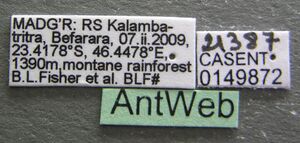Leptogenys edsoni
| Leptogenys edsoni | |
|---|---|

| |
| Scientific classification | |
| Kingdom: | Animalia |
| Phylum: | Arthropoda |
| Class: | Insecta |
| Order: | Hymenoptera |
| Family: | Formicidae |
| Subfamily: | Ponerinae |
| Tribe: | Ponerini |
| Genus: | Leptogenys |
| Species group: | attenuata |
| Species: | L. edsoni |
| Binomial name | |
| Leptogenys edsoni Rakotonirina & Fisher, 2014 | |
Leptogenys edsoni is known to nest most frequently in rotten logs and occasionally under the ground. Foraging occurs on the forest floor and in leaf litter.
Identification
A member of the attenuata species group. Rakotonirina and Fisher (2014) - Worker. Third antennal segment less than twice the length of second; eye breaking outline of side of head; mandible smooth and shining apart from scattered piligerous punctures; median lobe of clypeus mostly smooth and not markedly striate; metapleuron and each side of meso-metapleural suture finely rugose; with petiole in profile, posterodorsal angle of node not projecting posteriorly nor overhanging posterior margin.
Leptogenys edsoni can be separated from similar species in the attenuata group by its smooth anteromedian clypeal lobe and mandibles, the fine reticulate-rugae on the sides of posterior portion of mesosoma, and the straight posterolateral margin of the petiolar node.
Keys including this Species
Distribution
Madagascar endemic. This species occurs from Vohiparara near the PN Ranomafana in the northernmost range to the RS Kalambatritra in the south.
Latitudinal Distribution Pattern
Latitudinal Range: -23.4144° to -23.4144°.
| North Temperate |
North Subtropical |
Tropical | South Subtropical |
South Temperate |
- Source: AntMaps
Distribution based on Regional Taxon Lists
Malagasy Region: Madagascar (type locality).
Distribution based on AntMaps
Distribution based on AntWeb specimens
Check data from AntWeb
Countries Occupied
| Number of countries occupied by this species based on AntWiki Regional Taxon Lists. In general, fewer countries occupied indicates a narrower range, while more countries indicates a more widespread species. |

|
Estimated Abundance
| Relative abundance based on number of AntMaps records per species (this species within the purple bar). Fewer records (to the left) indicates a less abundant/encountered species while more records (to the right) indicates more abundant/encountered species. |

|
Habitat
Distributed in the mountainous regions of the southeast of the island and rarely in lowland rainforests.
Biology
|
Castes
Worker
Images from AntWeb
   
| |
| Holotype of Leptogenys edsoni. Worker. Specimen code casent0247255. Photographer Estella Ortega, uploaded by California Academy of Sciences. | Owned by CAS, San Francisco, CA, USA. |
   
| |
| Queen (ergatoid). Specimen code casent0149872. Photographer Jean Claude Rakotonirina, uploaded by California Academy of Sciences. | Owned by CAS, San Francisco, CA, USA. |
Nomenclature
The following information is derived from Barry Bolton's Online Catalogue of the Ants of the World.
- edsoni. Leptogenys edsoni Rakotonirina & Fisher, 2014: 46, figs. 1A, 20C, 28A, 63, 76 (w.q.) MADAGASCAR.
Unless otherwise noted the text for the remainder of this section is reported from the publication that includes the original description.
Description
Worker
(15 specimens). HW: 0.78–1.05, HL: 1.18–1.49, CI: 67–71, SL: 1.01–1.40, SI: 124–135, PW: 0.68–0.84, WL: 1.77–2.21, PNH: 0.53–0.68, PNL: 0.47–0.68, PNW: 0.44–0.57, DNI: 81–97, LNI: 85–116.
Head rectangular, sides almost straight and parallel to one another and meeting in rounded angle with very slightly concave posterior margin. In full-face view, eye diameter roughly one fifth the length of side of head, breaking line of side of head. Antennal scape extending beyond posterior cephalic margin by about one third of its length. Third antennal segment less than twice the length of the second. Posterior margin of propodeum at about level of propodeal spiracle with toothlike lobe. In profile, petiolar node higher than long; anterior face shorter than the posterior and rounding to dorsum, which meets the posterior face at a distinct angle, posterodorsal angle not projecting posteriorly and not overhanging posterior margin of node. Mandible smooth and shining between scattered punctures. Dorsum of head, median clypeal lobe, mesosoma, and petiolar node generally smooth and shining apart from small piligerous pits. Transverse striation or fine reticulate-rugae cover the propodeal declivity and along meso-metapleural suture; occasionally similar sculpture covers mesopleuron and lower half of propodeal lateral surface. Dorsum of body with short, yellowish-brown erect hairs and pubescence. Body color dark brown to black; tip of gaster and apical portion of appendages light brown.
Queen
(2 specimens): HW: 0.94–1.01, HL: 1.35–1.38, CI: 69–73, SL: 1.15–1.22, SI: 121–123, PW: 0.73–0.79, WL: 1.91–1.99, PNH: 0.65–0.71, PNL: 0.45–0.47, PNW: 0.59–0.64, DNI: 133–136, LNI: 146–150. Worker characters are also found in ergatoid queens, but the latter has a much shorter head, shorter but wider petiolar node, enlarged gaster and many more slender and numerous erect hairs. The mesosoma also lacks complete thoracic sclerites.
Type Material
Holotype worker: Madagascar, Toliara, RS Kalambatritra, Betanana, -23.4144, 46.459, 1360 m, montane rainforest, ex rotten log, 8 Feb 2009 (B.L. Fisher et al.) collection code: BLF21432, specimen code: CASENT0247255 (California Academy of Sciences). Paratypes: 5 workers same data as holotype but with the following specimen codes: CASENT0247209, CASENT0247252, CASENT0247253, CASENT0247254, CASENT0247256 (CASC, The Natural History Museum, Musee d'Histoire Naturelle Genève, Parc Botanique et Zoologique de Tsimbazaza).
References
- Rakotonirina, J.C. & Fisher, B.L. 2014. Revision of the Malagasy ponerine ants of the genus Leptogenys Roger (Hymenoptera: Formicidae). Zootaxa 3836, 1-163.
References based on Global Ant Biodiversity Informatics
- Rakotonirina J. C., and B. L. Fisher. 2014. Revision of the Malagasy ponerine ants of the genus Leptogenys Roger (Hymenoptera: Formicidae). Zootaxa 3836 (1): 001163.

